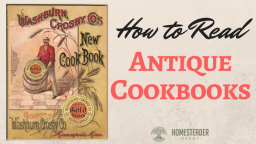Antique cookbooks are a wonderful relic of the past, and yet, if you’ve ever tried to make any of the recipes contained within, you might find yourself scratching your head.
Just as lifestyles have changed drastically in the last half, even quarter century, so have the way we cook, talk about, and interact with food, and the cookbooks of yesteryear might be a bit cryptic to today’s modern cook.
However, if you are a homesteader, these antique cookbooks might be very appealing to you. They are written for people who had access to the kinds of things homesteads produce, and deal with ingredients like whole animals, natural leavening agents, and tools wood fire stoves or ovens.
To help you decipher the archaic language of antique cookbooks, we’ve put together a little guide.
Leavening
The way we leaven our baked goods these days is very different from the way people did a century ago. While there is a big movement to return to natural leavening agents, you either might not be familiar with this technique yet, or simply don’t understand what the cookbook is calling for.
You might find yeast being called for by the cup or “teacup” in your antique cookbook, and this means an active starter like sourdough or a homemade yeast. You can also use dry yeast here (a relatively recent invention), but use 1 tbs for less than 6 cups flour, 2 tbs for 6-11 cups, or 3 tbs for 11-26 cups.
There have also been many changes in agents like baking soda and baking powder. If baking soda is called for, you’ll want to reduce the amount you use, as the baking soda we have today is double-acting, meaning it rises twice as fast. If the recipe calls for soda, 1/2 a tsp per cup of milk, sour milk, buttermilk, etc., or every teaspoon of vinegar or lemon juice.
Temperature
Most old cookbooks assumed that the reader already knew how to operate their oven and range, so most of the time, ingredients, and steps for preparing the dish are given, but with only a few vague instructions for baking at best. Since gas ranges and ovens weren’t common until well into the 20th Century, anything written before that wouldn’t assume you were using one.
In many cases, you’re simply going to have to use common sense. Odds are if you’re brave enough to dive into an antique cookbook, you are probably pretty comfortable in the kitchen, and know that, for the most part, certain baked goods tend to be baked around the same temperature. If you’re confident baking on a regular basis, you should be fine. If you’re confused, reference the temperature used in a contemporary version of a similar recipe, and just watch your dish carefully as it bakes.
Measurements
Old-fashioned cookbooks have some odd standards of measurements. For instance, “teaspoons” are the same word, but the measurement has changed. It used to be 4 tsp per 1 tbs, while our present measurement is 3 tsp per 1 tbs. Also, when teaspoons or tablespoons are indicated in old cookbooks, they might have meant rounded, while today we typically refer to these measurements as the flattened-off version. These rounded, or “heaping” measurements, means that there could be nearly double the amount in one measurement!
You also might find some unusual words you don’t recognize. A “dessertspoon” is half a tablespoon, meaning that, when a tsp equaled 1 tbs, a dessertspoon would be 2 tsp (today you might simply have a half-tablespoon measuring spoon on your personal set, I do).
Other measurements that might be unfamiliar are a “salt-spoon”, which is is 1/8 of a tsp, a “dash” (still used today in many cookbooks) is one shake of a shaker.
A “cup” in an old-fashioned cookbook might mean about 1/5 less than our modern 8 oz cup. “Teacup”, a phrase you won’t see anymore, is simply half a cup. “Wineglass” is the equivalent of our current 1/4 a cup. Sometimes, you might see a recipe call for a “bowl”, use your best judgment using one of your own bowls, based on the other proportions in the recipe.
While some old-fashioned recipes from antique cookbooks might be a bit daunting at first, never fear. While cooking language and techniques have changed, for the most part, it’s all still food. If you’re confident cooking on a daily basis, you can probably use your best judgment to make the recipe work for you. These old cookbooks can contain timeless wisdom when it comes to food, and since homesteading is all about getting back to our roots, its important to take advantage of these antique resources.
If you enjoyed this, you might also like….
Long-Term Survival for Homesteaders…
Natural Healing Secrets You Need to Know…
Effective Primal Diet Hacks…

